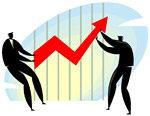The official statistics has published the first post-election report on macro-economic indicators.
This report evolves the information collected promptly during the period of January-April. This is preliminary report, but it is not so bad though.
The economic activity rate for January-April was 7.2% compared to the same period of the previous year. This means that the economic activity indicator exceeded the growth rate planned by the budget.
This report will again focus on the production sector and again will report double-digit growth. During January-April the capacity of the production sector amounted to 317.4 billion drams, which is more by 15.3% than the same indicator of the previous year. In April the capacity of produced products grew by 45.1% compared to March. The sector of energy production, which is closely connected with production sector too, grew by 13.3%.
Double-digit growth (10.1%) was observed in the sector of services s well. During the four months of this year the capacity of services produced amounted 285 billion drams. The growth of the sector of services can be partly conditioned by the adoption of the system of compulsory insurance, which has increased the financial circulation of insuring companies by several billions.
Double-digit growth was observed in foreign trade and export as well. During January-April the capacity of export from Armenia amounted 440 million dollars. The growth compared to the previous year was at 17.8%. The growth of import was at 8.7%, but the import capacity is three times more (1.312 bln dollars) than the export. The negative balance of foreign trade 872 million dollars.
The other indicators are not so good. In January-April the sector of agriculture grew by 1.1% only. The trade turnout was at 0.9%. Even though the other sectors are growing, it has been a long time that the trade turnout does not move.
According to statistics services, the average monthly nominal salary has grown by 5.3% and reached 115,000 drams. In state institutions the average salary was 92.307 drams, and in private companies – 142.700 drams. According to this statistics report, during 12 months (from April to April) the inflation rate was 1.9%. This means that they want to convince us that we have started to live better as the salaries are growing faster than the consumer prices. The worst indicator concerns the sector of construction as during January-April the capacity of the turnout in construction was less by 5.2% compared to the same period of the previous year. This is becoming a tendency as it has been a long time the construction sector cannot go out of crisis. Anyway, the government may be proud of this indicator. Whatever happens, the government will continue trying to convince people that everything is going to be fine in this sector as well. During a recent session of the government the prime-minister spoke about the monetary policy and said that the situation had become stabile and international institutions appreciated the policy of the government for that purpose. “We see that in 2011 the macroeconomic stability of our economy was strengthened and it is a big positive achievement. We will continue this policy. We see that the Moody’s international organization that gives ratings is estimating our economic rating highly positive, which gives more impetus to continue the economic growth. We were often criticized for ineffective monetary policy, but we see that international famous organizations are giving different estimations to our policy. It is understandable that the world is moving according to those estimations,” said the prime-minister. By the way, speaking of international organizations it is worth mentioning that the Reconstruction and Development European Bank (RDEB) recently published a report, which also covered a section about the macroeconomic situation of Armenia’s economy. For example, our government was allegedly saying that we had overcome the crisis and the economy was in recovering phase, but the experts of the RDEB find that Armenia is moving out of the crisis slowly. They report that the main impetus for Armenia’s post-crisis recovering is the reproduction and mining sectors.
And we’d like to present the following segment with no cuts, “The Armenian government has undertaken a range of steps aimed at improving tax administration and systematic changes. Those were projects which had the high level of support from the International Monetary Fund. The Armenian economy also benefits from state financing and especially from the volume of monetary remittances coming from abroad. At this point the most risky elements of the Armenian economy are the foreign remittances that make our economy dependent and the scarcity of export goods.” In the end, let us remember that according to the RPA pre-election platform the economy of Armenia should be focused on the development of internal production and industry. It means that we shouldn’t become too encouraged by the 18% growth of export but we should pay attention to what we are exporting. Judging from the above-mentioned indices, economic development is not a priority yet.

